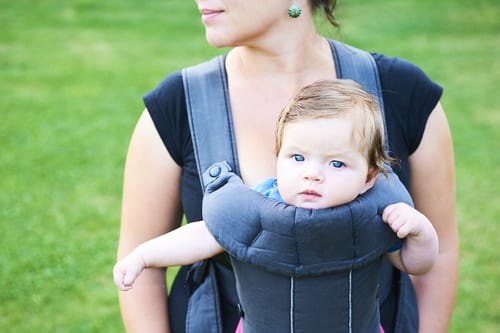Having a baby routine can make life so much easier. Babies thrive on a schedule and enjoy the security of knowing when things are going to happen. This is probably why sleep training programs like the Sleep Sense program dedicate entire sections to scheduling.
It can be great for parents too to know when their baby will need a feed or a nap so that they can work it into their day, or around the programme of a busy toddler.
If you’re someone who isn’t keen on sticking to a set routine every day then that’s fine. There is no right or wrong way to do things when it comes to deciding to go with a baby routine or free flow, only what works for you and you will find your own rhythm.
This article shows you how to start a baby routine. If you’re interested in doing so but don’t quite know how to start, then read on! In this complete guide for a 2 month old sleep schedule we break down how to set up your baby’s routine and how to gently keep them in a routine. We also provide a sample ‘baby schedule’ to show what baby’s day might look like.
Do babies fall into their own routine?
Of course it would be lovely if babies just magically found their own routine. And they sometimes do.
The only problem is, left to their own devices, they can decide to nap at teatime and then won’t settle at bedtime. Or they decide that 4 am is a brilliant time for playtime.
Just by doing little things to keep them on track with their routine, can be a real help for everyone.
You might notice that your baby moves into more predictable patterns of feeding and sleeping, all on their own. You can use their natural rhythms as a baseline to gently encourage them into a routine that works for your baby and for the whole family.
 Does my baby really need a routine?
Does my baby really need a routine?
Parenting experts have differing opinions when it comes to implementing a baby routine.
Some, like Gina Ford, recommend following a strict timetable to shape your baby’s schedule.
Others, like William Sears, believe mothers should tune into their baby’s cues for food and sleep and let their day evolve according to these needs.
There is no right or wrong way but having some sort of regular routine can make life easier.
Tanya Remer Altmann, editor-in-chief of The Wonder Years: Helping Your Baby and Young Child Successfully Negotiate the Major Developmental Milestones, believes that a routine can make babies happier. She says:
When they’re not sleep-deprived or hungry, it makes for a much happier baby. By meeting your baby’s basic needs, you put her in the best frame of mind – and body – to learn about and explore her new world. Tanya Remer Altmann
Taking note of your baby’s natural rhythm
You will already have a good idea of your baby’s natural rhythm of feeding, sleeping and being alert for play throughout the day. But it really helps to write it all down so that you can look over it and see things that you may not have noticed before.
You can use apps such as Trixie Tracker to help you uncover patterns in your baby’s sleep times and daily activity.
Write out their sleeping and feeding patterns over 1-2 weeks. then study it and notice what they like and don’t like:
- how much sleep are they needing in one day?
- how long can they can stay awake for happily before getting tired?
- how much milk are they needing every day?
- when do they prefer to have that one longer sleep in the day?
You can soon work out the natural times for your baby’s routine.
You can then make a timetable based around that and encourage them to be more consistent by offering feeds at the same time each day, going out together or playing with your baby at similar times. It also helps if they nap at regular times.
By having one place where they have most of their naps (like their crib in a quiet room) they will soon learn that when they are put in the crib that it’s time to sleep.
The first 6 weeks with baby
For the first 6 weeks with baby are a magical time. During these weeks it’s best to follow their lead. Their feeding patterns will change from day to day (and hour to hour!) as will their sleeping patterns.
 Feeding patterns emerge
Feeding patterns emerge
Hopefully towards the end of the 6 weeks they will slowly fall into a vague pattern of feeding every 3 hours.
Even at night, you will probably have to wake them if they have not fed for 3.5 hours to make sure that they are getting enough milk. This on its own creates a kind of natural 3 hourly schedule.
For example you might find they end up feeding at 7am, 10am, 1pm, 4pm, 7pm and again through the night on most days. Some days they’ll eat more frequently, and it will almost never be perfect (so don’t expect it to be) but you will probably start noticing some patterns.
Never deny a newborn baby milk or make them wait for a feed or a sleep. This age is all about helping them gain weight, and helping them learn to feed and sleep.
Self settling
One thing you can do at this age is help baby to learn to settle themselves. As your baby gets tired, watch them for cues that they are ready for bed. Pop them in the crib when they are sleepy but not overtired to allow them to drift off to sleep on their own.
This simple practice can help show them that they are able to put themselves to sleep rather than feeling that they always need someone there to be able to sleep.
This won’t work all the time, (often they just need those cuddles) but if you can help them to self settle some of the time it will do wonders in setting you up for the next phase.
Nap schedule at 4-6 weeks
As they approach 4 weeks old, you may notice that your baby is starting to stay awake for short amounts of time. This is a great time for them to have their first play times!
They may enjoy looking at a black and white image, or a mobile or toy. Or they probably just love to look at your face and chat to you. For more ideas on playtime see our article First games to help your newborn thrive.
This awake time means you can start to introduce a little ‘wake – eat – play – sleep’ cycle at each feed.
Wake – baby wakes up from their nap.
Eat – baby has their milk feed as soon as they wake. As they have just had a good sleep, they will tend to be calmer, more relaxed. They are also less likely to fall asleep on the breast or bottle and therefore more likely to have a full feed.
Play – after their feed they can have a little awake time or ‘play time’ while feeling rested and full.
Sleep – keep a close eye out for baby’s tired cues as they play. They might fidget, start to whine a little or get more agitated.
Put them down to sleep in their crib when they start to get tired. You want them to be sleepy but not overtired. When they get too tired it can mean they end up crying a lot and need a long time and a lot of rocking to settle.
You might notice that your baby can stay awake for a set amount of time, for example 30 minutes before getting tired. This will help you get an idea of when they need to be put down to sleep. As baby grows this awake time will slowly get longer at certain times of day and you can adjust the routine accordingly.
2 month old sleep schedule that works for you
As baby gets older, they will generally start pushing from 30 minute wake times towards 1.5 hour awake times. This can help them to settle into a pattern of 3 naps throughout the day and hopefully slightly longer sleeps at night.
Your baby routine at 2-4 months old may look something like the below. It’s based on the assumption that baby is having full milk feeds every 3 hours.
It is intended as a guideline that you will need to adjust it to meet your own baby’s sleeping and feeding needs.
We recommend that you write out your own baby’s feeding and sleeping patterns.
Write down when they like to sleep and for how long. How many hours of sleep do they need in 24 hours?
When do they feed the most and how often to they feed? If they’re bottle feeding, how much milk are they having per feed?
Keeping these needs in mind, together with the below guideline, can help you to create your own baby schedule that suits your own baby.
Younger babies will naturally need to sleep more and feed more frequently. As they get older their awake times get longer and their nap times gradually reduce naturally.
| 7 am |
First FeedFirst milk feed of the day, followed by playtime. |
| 8.30 am |
First napBaby has their first morning nap. At first this is usually a long one of about one and a half hours. It can start to shorten naturally as baby gets older. |
| 10 am |
Second feedBaby wakes or if they don’t wake you may have to gently wake them. Baby has their morning feed and a play. |
| 11.30am |
Second napBaby can have a longer afternoon nap. This can be 2-2.5 hours long, if they want to. As a rule of thumb it’s advised not to let them sleep for over 3 hours at any one nap during the day. This is because babies tend to have one longer sleep in a 24 hour day and you really want this to be during night time hours and not during the day time. |
| 2pm |
Third feedBaby wakes from their afternoon nap and has another milk feed. |
| 3.30-4pm |
Third napBaby has a late afternoon nap (third nap) here. As this one is right before night time it can start as a long 1.5 hour nap and gradually get shorter as baby gets older. Most babies do this naturally. You want them to be a little bit more tired before bedtime so that you’re encouraging those long sleeps at night time. |
| 4.30-5pm |
Fourth feedBaby has a late afternoon feed. |
| 6pm |
Start your bedtime routineStart getting baby ready for bed with your preferred bedtime routine. Some ideas are a warm bath with a splash in the water , a calming massage and a baby book. |
| 7pm |
Fifth feedBaby has their evening bottle and settles to sleep for the evening. For this bottle it’s a good idea to do this in a quiet room, with dim lighting and no sounds around to help baby relax. Night time sleepWhen you put them to sleep at this time, make sure the room is quiet and the lights are dim or turned off. This helps encourage baby to have longer sleeps during these hours. They will gradually learn the difference between loud, bright day times and quiet, calm night times. |
| 10pm |
Dream feed (sixth feed)The 10pm feed is sometimes be called a ‘dream feed‘ as baby can stay sleepy and many even drink with their eyes closed. After they finish, burp them and gently put straight back in their crib. You can leave your baby to sleep for longer after this feed in order to guide them into a natural night time routine. 10pm-2am are also the hours that you are most likely to be sleeping as well so you can get some much-needed rest. |
| 2:30am |
Seventh feedBaby will have their first night time feed. Keep this feed as sleepy as possible. Burp baby and try to get baby back to sleep afterwards without playtime. |
| 5am |
Eighth feedBaby might have their second night feed. Keep this feed as sleepy as possible. Burp baby and try to get baby back to sleep afterwards without playtime. |
| 7am | Baby wakes and the day begins. |
Encourage one longer nap in the day
As you can see baby has two shorter naps in the day, one in the morning (first nap) and one in the late afternoon (third nap), and one longer nap in the day at lunchtime (second nap).

You want to encourage that longer sleep in the afternoon which can go up to 3 hours if baby needs it.
However for the morning and late afternoon naps though you want to try and keep those shorter.
You don’t really want them to sleep for longer than 1.5 hours so you may have to wake them for their feed to keep them on schedule. As they get older these naps should reduce to 1 hour or sometimes 40 minutes which baby usually does on their own.
Always allow enough sleep time during these naps for baby to feel relaxed and rested (exactly how long each baby needs varies from baby to baby) but you don’t want them to sleep for long stretches here.
There will be days where it’s taken you 1 or 2 hours to settle baby to sleep you don’t want to wake them up after 40 minutes just to keep them on the right feeding schedule. Instead let them sleep for a good amount and push the next feed back a bit. You can get back on track later in the day or the next day.
As baby gets older, disturb them less and less during the nighttime sleeps to encourage longer sleeps during those times.
Tweak your baby’s sleep schedule so it works for you
Remember no one knows your baby better than you, so you can use this routine as a baseline to adapt to however suits you and your baby.
You might find for example that your little one prefers a longer nap in the morning rather than the early afternoon. If this works for you as well and what you need to do in the day, then you can make the morning nap (nap 1) the longer one, and keep the other two a little shorter.
 Another consideration is when does it work for you for baby to have that long nap in the day? You might have to pick up your older child from nursery or playgroup at 12 so you might want baby to come with you and sleep when you get back home at 12.30 rather than 11.30 as shown in the sample routine above.
Another consideration is when does it work for you for baby to have that long nap in the day? You might have to pick up your older child from nursery or playgroup at 12 so you might want baby to come with you and sleep when you get back home at 12.30 rather than 11.30 as shown in the sample routine above.
If this is the case they you can move everything forward an hour so that baby can do this. So you would start baby’s day at 8am (rather than 7am), have their second feed at 11am (rather than 10am), then leave for the nursery pick up, and get back to put them to sleep when you return home at 12.30pm. Hopefully your toddler will have a nap too and you can have a moment to relax as well during the day with both kids asleep.
Little shifts of an hour backwards or forwards are very easy to implement. Make the routine work a little for you and your family as well.
As long as your baby’s sleep needs are being met, you can tweak your schedule here and there, so that it makes your day easier and more manageable.
However you do it, the most important things are that baby is getting enough sleep and milk. After that, as long as you are consistent with the routine you choose, your baby will settle into it.
They will soon develop a nice pattern of eating, playing and sleeping. They will learn when to expect feeds and when to expect sleep. This will hopefully make them calmer and happier babies.
Why rigid napping schedules can help baby sleep better
Organising a schedule round your baby’s nap time can actually help them sleep better at night and nap for longer. Nicole Johnson, writing for The Baby Sleep Site says:
By prioritizing your baby’s sleep and making sure she’s in her crib at nap time and bedtime will make it that much more likely that she will sleep through the night and ensure your baby naps longer. You are making sure that you are putting her down during her “sleep windows” and helping “set” her internal clock. Nicole Johnson
Johnson believes that a more rigid schedule is even more useful if your baby is highly sensitive or sensitive to becoming overtired. She says:
it is usually best to keep a rigid sleep schedule from a sleep perspective…because it helps “set” their internal clock and biological rhythms. Nicole Johnson
Other babies will be better suited to a more flexible schedule. Johnson points out that being too much of a slave to a schedule can have problems too. She argues that
Being too rigid may land you into a cycle of chronic over-tiredness, which is sometimes hard to break. Nicole Johnson
You know your baby better than anyone and you will soon learn whether they thrive on routine or are more able to go with the flow.
Babies don’t work like clockwork
It’s important to say that babies don’t run like clockwork and neither does real life. Don’t feel discouraged if there are days where it all goes out the window. Those days will happen. Just write it off and get back on track the next day.
Things in life might also crop up that might change the routine of your day. Or your baby might go through a growth spurt or phase, which upsets their usual routine.
It’s also useful to be a little flexible with baby’s schedule so that you can enjoy your day and say, meet up with mums or friends. Don’t feel tied to the home. Baby can nap in the pram for once, so there can be ways to work their routine into your day and what you need to do.
Watch out for growth spurts
Babies go through growth spurts, which can knock them out of their routine and interrupt their naps, sleep and feeds. You may notice that your baby is fussier or crankier than usual during these times. Growth spurts can happen at any time but some key ages are:
- two weeks
- three weeks
- six weeks
- three months
- six months
It’s disheartening when any routine you have built up goes awry during growth spurts but if you stay as consistent as you can be through it, things soon settle back down.
Adjust baby’s routine as they get older
As your baby grows, they will go through certain changes. They will be able to stay awake for longer, and their morning and late afternoon naps are likely to become shorter. Eventually they’ll start eating a few solid foods alongside their milk feeds so their feeding times and habits will change.
As you see these changes emerging over the weeks and months, adjust their routine organically to give them what they need. You might see, for example, that your baby is sleeping less (or not at all) during their morning nap, so they need to have their main nap of the day by 12 noon to not be too tired. You might therefore decide to give them their ‘lunch’ milk feed or puree at 11:30, instead of at 12.30 so they can go to sleep satisfied with a full tummy. Adjust it slowly to suit your own baby’s needs.


 Does my baby really need a routine?
Does my baby really need a routine? Feeding patterns emerge
Feeding patterns emerge